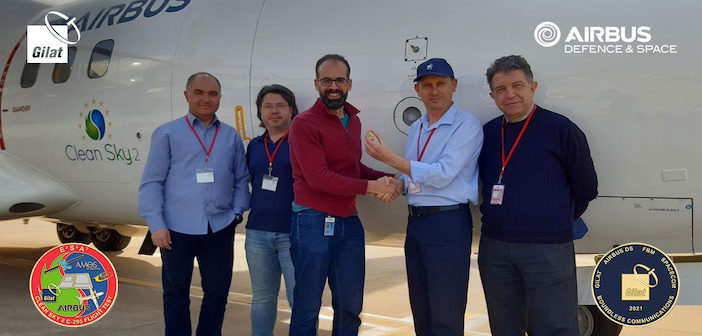IFC antenna achieves ‘breakthrough’ during Airbus flight tests

Following results from flight tests conducted by Airbus Defence and Space, Gilat Satellite Networks, an Israel-based specialist in satellite networking technology, announced it has achieved “a breakthrough” in electronically steerable antenna (ESA) technology for inflight connectivity (IFC).
The Amos-17 satellite was used with a steerable beam pointed to the flight area in southern Spain, and cross-linked to a fixed beam serving the SkyEdge II-c Hub. The conclusion of the flight tests, with the connectivity capability demonstrated on Spacecom’s AMOS-17 advanced digital Ka band satellite, marks the successful completion of the final phase of the five-year Clean Sky 2 IFC ESA project.
Clean Sky 2 is a European research programme developing innovative technology aimed at reducing the CO2, gas emissions and noise levels produced by aircraft. Funded by the EU’s Horizon 2020 programme, the Clean Sky 2 research and innovation project aims to contribute to strengthening European aero-industry collaboration, global leadership and competitiveness.
Gilat says its ESA technology, operating with Gilat’s SkyEdge II-c platform and Taurus aero MODMAN, is now proven to be at the forefront of the next generation of the ESA IFC market. The ESA in question is a flat antenna that is fully integrated and validated on the Airbus C295 Flight Test Bed 2, an inflight demonstrator of the Clean Sky 2 programme.
“Gilat’s ESA demonstrated a high level of robustness throughout the test flights, maintaining a stable link during quite aggressive manoeuvres of the aircraft, and over-achieving performance expectations,” said Luis Benitez, chief engineer of Clean Sky 2 Regional FTB2 at Airbus. “Gilat’s ESA, conformally integrated within the wing-to-fuselage fairing of the airplane without adding aerodynamic drag, supports a more efficient, quieter, and more advanced aircraft for a wide variety of applications.”
“The successful flight-test of our fully integrated ESA technology was done in collaboration with our long-standing partners FBM, Airbus, and Spacecom, setting the standard for next generation of SATCOM systems for IFC,” added Alex Volodarsky, director of SatCom On-the-Move Programs at Gilat. “We have proven our ability to develop and deliver state-of-the-art ESA technology operating with Taurus, our globally deployed aero MODMAN, that adheres to the most stringent requirements of the aerospace industry. We expect our ESA technology to be widely adopted in the IFC market in the coming years, especially in view of numerous NGSO constellation deployment plans.”
